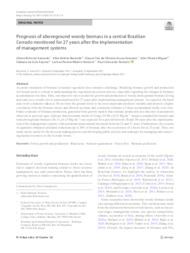Prognosis of aboveground woody biomass in a central Brazilian Cerrado monitored for 27 years after the implementation of management systems.
Prognosis of aboveground woody biomass in a central Brazilian Cerrado monitored for 27 years after the implementation of management systems.
Author(s): AZEVEDO, G. B. de; REZENDE, A. V.; AZEVEDO, G. T. O. S.; MIGUEL, E. P.; AQUINO, F. de G.; TEODORO, L. P. R.; TEODORO, P. E.
Summary: Accurate estimation of biomass in natural vegetation sites remains a challenge. Modeling biomass growth and production in Cerrado areas is crucial to understanding the vegetation succession process, especially regarding the changes in biomass accumulation over time. Thus, our objective was to model the growth and production of woody aboveground biomass (living and total) in a cerrado stricto sensu monitored for 27 years after implementing management systems. As expected, the basal area (with a diameter taken at 30 cm from the ground level) is the most important predictor variable and showed a higher correlation with the biomass stocks and allowed accurate and consistent estimates of these accumulated stocks over time. Future estimates of biomass production, generated from growth models that estimate production as a function of parameters observed at previous ages, indicate that maximum stocks of living (25.86 ± 0.15 Mg ha−1 [mean ± standard deviation]) and total aboveground biomass (26.11 ± 0.15 Mg ha−1) are expected for a period between 28 and 30 years after the implementation of the management systems, with maximum mean annual increment between 23 and 27 years. Furthermore, the systems of equations obtained simulated reductions up to 30% of biomass after the occurrence of a forest fire at 23 years. Thus, our study can be useful for the decision-making process and developing public policies and strategies for managing and conserving natural resources in the Cerrado biome.
Publication year: 2021
Types of publication: Journal article
Unit: Embrapa Cerrados
Observation
Some of Embrapa's publications are published as ePub files. To read them, use or download one of the following free software options to your computer or mobile device. Android: Google Play Books; IOS: iBooks; Windows and Linux: Calibre.
Access other publications
Access the Agricultural Research Database (BDPA) to consult Embrapa's full library collection and records.
Visit Embrapa Bookstore to purchase books and other publications sold by Embrapa.

